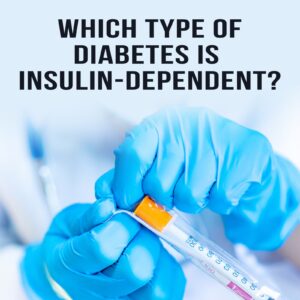
Diabetes is a chronic health condition that affects how your body turns food into energy. It involves problems with the hormone insulin, which is produced by the pancreas and helps cells absorb glucose (sugar) from the bloodstream. There are several types of diabetes, but one that specifically requires insulin administration is Type 1 diabetes.

What is Type 1 Diabetes?
Type 1 diabetes, formerly known as juvenile diabetes or insulin-dependent diabetes, is an autoimmune condition where the body’s immune system mistakenly attacks and destroys the insulin-producing beta cells in the pancreas. As a result, the body can no longer produce insulin, the hormone essential for allowing glucose to enter cells and provide energy. Without insulin, glucose remains in the bloodstream, leading to high blood sugar levels, which can cause serious health problems over time.
Causes of Type 1 Diabetes
The exact cause of Type 1 diabetes is still unknown, but it is believed to result from a combination of genetic predisposition and environmental factors, such as viral infections. Unlike Type 2 diabetes, Type 1 is not linked to lifestyle factors like diet or exercise. It typically manifests in childhood or adolescence, but it can occur at any age.
Symptoms of Type 1 Diabetes
The symptoms of Type 1 diabetes often appear suddenly and can include:
– Increased thirst and frequent urination: Excess glucose in the bloodstream causes the kidneys to work harder to filter and absorb it. When they can’t keep up, the excess glucose is excreted into urine, dragging fluids from tissues, leading to dehydration and frequent urination.
– Extreme hunger: Without insulin, glucose can’t enter cells to provide energy, leading to persistent hunger.
– Unintended weight loss: Despite eating more, people with Type 1 diabetes may lose weight as their body begins to use muscle and fat for energy.
– Fatigue and weakness: Lack of glucose in the cells results in a feeling of constant tiredness.
– Blurred vision: High blood sugar levels can pull fluid from the lenses of the eyes, affecting the ability to focus.
Managing Type 1 Diabetes
Since individuals with Type 1 diabetes cannot produce insulin, they must rely on insulin therapy for survival. This involves regular administration of insulin, either through injections or an insulin pump. The goal is maintaining blood sugar levels within a target range to prevent complications.
- Insulin Therapy: There are different types of insulin (rapid-acting, short-acting, intermediate-acting, and long-acting), and a treatment plan is tailored to each individual’s needs. The choice and timing of insulin administration are critical for mimicking the body’s natural insulin response.
- Blood Sugar Monitoring: Regular monitoring of blood glucose levels is essential for managing Type 1 diabetes. This can be done through fingerstick tests or continuous glucose monitoring systems, which provide real-time data on glucose levels.
- Diet and Exercise: Although lifestyle factors do not cause type 1 diabetes, diet and exercise are crucial in managing the condition. A balanced diet helps regulate blood sugar levels, while physical activity can improve insulin sensitivity and overall health
Complications of Type 1 Diabetes:
Without proper management, Type 1 diabetes can lead to several serious complications, including:
– Cardiovascular disease: High blood sugar levels can damage blood vessels, increasing the risk of heart disease, stroke, and other cardiovascular issues.
– Nerve damage (neuropathy): Excess sugar can injure the walls of the tiny blood vessels that nourish nerves, particularly in the legs, leading to tingling, numbness, and pain.
– Kidney damage (nephropathy): The kidneys contain millions of tiny blood vessel clusters that filter waste from the blood. High blood sugar can damage this delicate filtering system, leading to kidney failure.
– Eye damage (retinopathy): Diabetes can damage the blood vessels in the retina, potentially leading to blindness.
– Foot damage: Nerve damage in the feet increases the risk of various foot complications, including infections that can lead to amputations in severe cases.
Living with Type 1 Diabetes:
Living with Type 1 diabetes requires ongoing management and attention. With advancements in technology, such as insulin pumps and continuous glucose monitors, people with Type 1 diabetes can lead full and active lives. Education, self-care, and support from healthcare professionals are key components of managing this condition effectively.
In conclusion, Type 1 diabetes is a serious, lifelong condition that requires diligent management with insulin therapy. By understanding the nature of the disease, its causes, symptoms, and management strategies, individuals with Type 1 diabetes can take control of their health and prevent complications, leading to a better quality of life.








